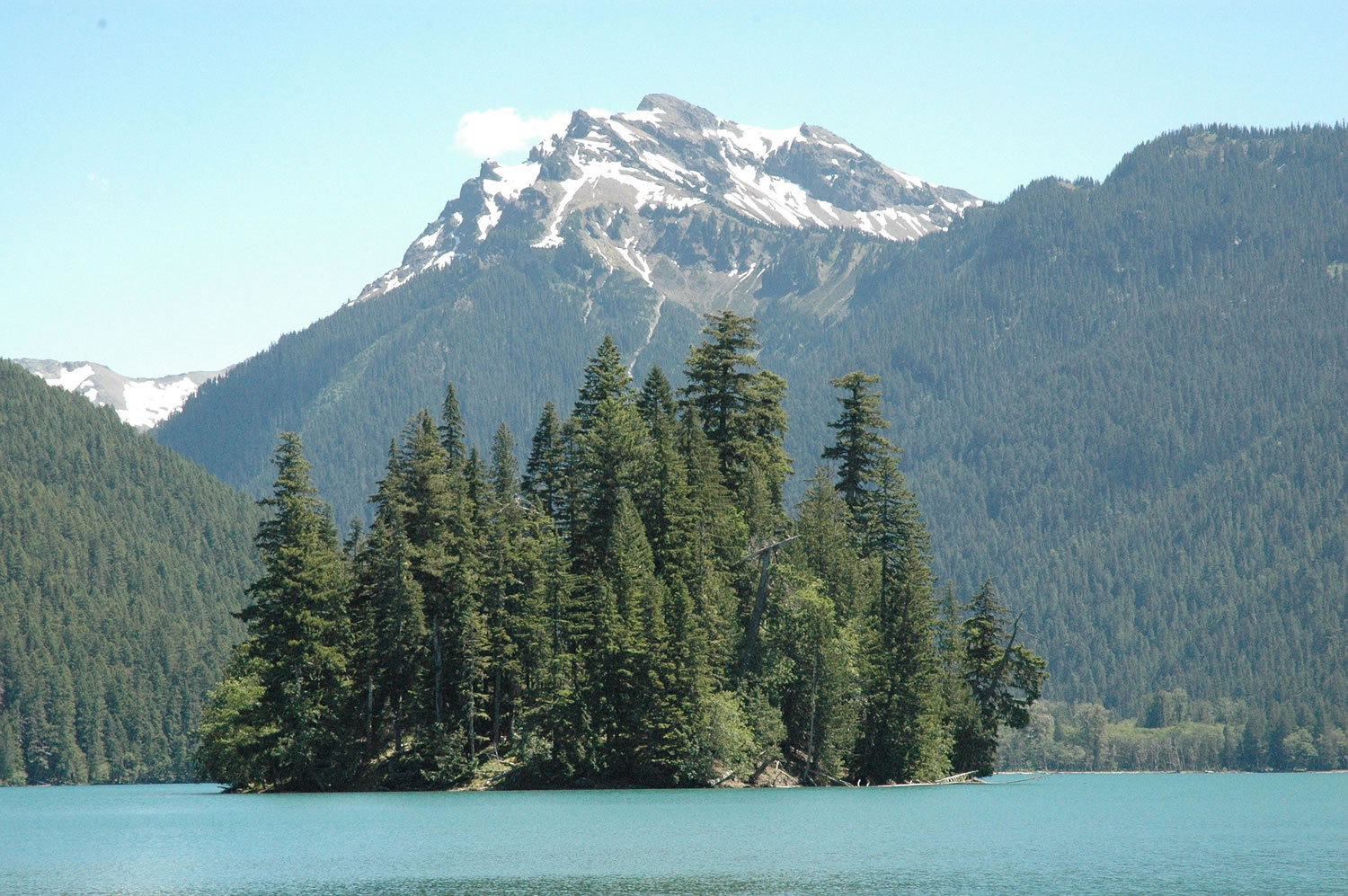PACKWOOD, Wash. — Forty-six years ago, when updating its recreation maps, the Forest Service chose Packwood Lake for the photograph epitomizing the backcountry beauty of the Gifford Pinchot National Forest.
It was a good choice then, as it is today.
With Johnson Peak looming overhead, the big lake on the edge of Goat Rocks Wilderness is a calendar-cover scene.
Follow Interstate 5 to U.S.Highway 12 at exit 68, then go east on Highway 12 to the community of Packwood in eastern Lewis County. Turn right on Snyder Road and follow it 5.7 miles to the trailhead parking lot.
A Northwest Forest Pass is needed for parking.
The late Russ Jolley, in his 1976 Gifford Pinchot hiking guide, called it “one of the most beautiful lakes anywhere.”
And while it’s a nearly three-hour drive from Clark County followed by a two-hour hike, Packwood Lake is a trip worth making for Gifford Pinchot aficionados. It’s one of the signature locations in the north end of the forest.
Packwood Lake is a lake and a reservoir.
About the turn of the millennium — as in 1000 A.D. or so — a chunk of Snyder Mountain broke away and slid into the creek below, creating Packwood Lake.
Then in 1964, the Washington Public Power Supply System — now named Energy Northwest — built a dam at the outlet of Packwood Lake that diverts most the flow of Lake Creek into a four-mile pipeline down to a power plant near Packwood.
The dam raised the lake level about 10 feet.
Two routes lead to the 452-acre lake, five miles east of the Lewis County community of Packwood. Both begin at the end of Snyder Road, which becomes Gifford Pinchot forest road No. 1260.
Hikers mostly use Packwood Lake trail No. 78, which leads 4.3 miles to the lake. The trail climbs and descends gently.
“It’s an easy hike,” said Kevin Peach of Shelton, Wash. “We hike the Olympics a lot and that’s a lot of up and down. The grade here was very gradual.”
Cyclists, motorcycles and all-terrain vehicle users are allowed access to the lake via Pipeline trail No. 74.
The boundary lines for the Goat Rocks Wilderness are such that the lake is not in the wilderness area, thus its accessibility by motorized vehicles.
In 1907, Valley Development Co., a forerunner of Portland General Electric, began surveys for a potential hydroelectric plant at Packwood Lake. Reportedly, a 100-foot-tall dam that would have backed up the lake another five miles was considered.
In 1910, Valley Development built Packwood Lake trail.
By 1917, the Forest Service had assumed ownership of the Valley Development Co. holdings and established a campground at Packwood Lake.
The Forest Service later built a two-story cedar lodge and several small cabins at the lake for vacationers. Although the lodge and most of the cabins were torn down after a fire in the mid-1970s, the rowboat concession operated until 1991.
Still at Packwood Lake is a historic ranger station built in 1910 and a newer unused guard station.
Jack Thorne of the Gifford Pinchot’s Cowlitz Valley Ranger District said the guard station is used when the Forest Service has money for a local guard or wilderness rangers working in Goat Rocks.
It’s been years since there has been money for either.
The 1910 guard station has been restored a couple of times. Thorne said.
There are no plans to added it to the recreation rental program due to issues with the building and its location, he added.
Packwood Lake averages more than 70 feet deep, with places as deep as 120 feet.
The lake has a native, self-sustaining population of rainbow trout. A study of the trout in 1982 found the fish to be genetically unique, and more akin to inland trout populations than those from the coast.
A 1989 document by former state Department of Fish and Wildlife biologist Bob Lucas reports that Packwood Lake was used as a source of rainbow trout as early as 1916. The lake was stocked intermittently between 1933 and 1965, yet data showed the rainbow trout “remained remarkably pure.”
In 1989, there was a resort at Packwood Lake with a small store, two overnight cabins and boat rentals, he wrote.
Lucas reported then that Packwood Lake was fished by an estimated 75 people on peak weekends and the annual harvest was 4,000 to 5,000 trout.
Thorne said the lake still gets fished substantially.
“People pack in small inflatables, even canoes on wheeled carts on the low trail (Pipeline No. 74),” he said.
Trout spawn in most of the lake’s tributaries from mid-May to July.
Biologist John Weinheimer of the state Department of Fish and Wildlife said the agency’s most recent survey of spawners was in 2007.
EES Consulting Inc. of Bellingham conducted extensive spawning surveys of Packwood Lake tributaries in 2007 as part of the relicensing effort for the hydro project.
EES counted slightly more than 4,800 spawning rainbow in seven tributaries of Packwood Lake.
The lake is open to fishing from the last Saturday in April through Oct. 31 with a 10-inch minimum-size limit and a five-fish daily limit. Only flies or artificial lures with single, barbless hooks are allowed. Bait is prohibited.
Internal combustion engines also are banned. Access to Agnes Island in the lake is prohibited.
Energy Northwest must maintain the lake at approximately its natural level between May 1 and Sept. 15, the summer recreation season. During the rest of the year, Packwood Lake can be lowered as much as eight feet.
The power plant produces 27.5 megawatts of electricity, enough to power about 900 homes.
Energy Northwest’s federal operating license expired in 2010. The utility is operating the hydro project under one-year extensions of the original license while the awaiting a new one, said John Dobken, a senior public affairs analyst.
The Forest Service hopes to get financing from Energy Northwest for a recreation ranger at Packwood Lake as part of the federal relicensing.




